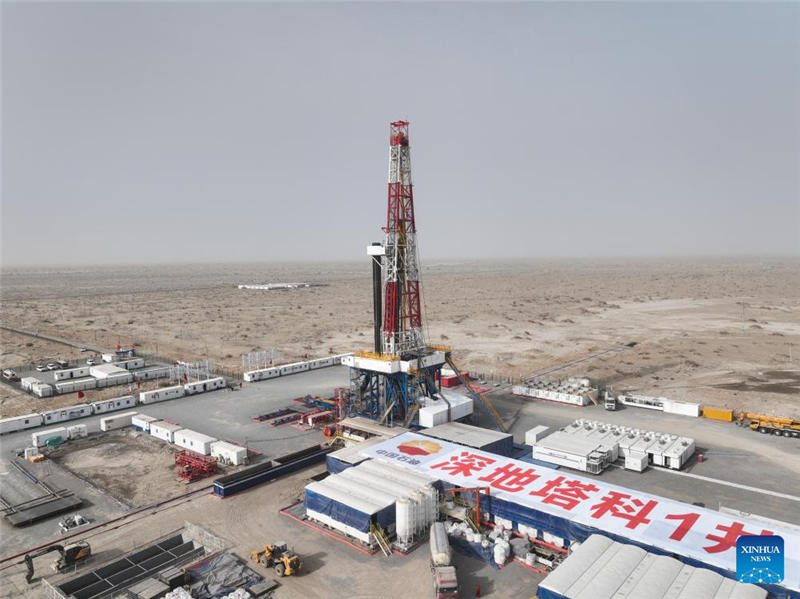
A drone photo taken on March 4, 2024 shows the "Shenditake 1" borehole in the Taklimakan Desert in the Tarim Basin, northwest China's Xinjiang Uygur Autonomous Region. The drilling of a superdeep borehole in northwest China's Xinjiang Uygur Autonomous Region reached 10,000 meters at 2:48 p.m. Monday and is going deeper, marking a breakthrough in the country's deep-Earth exploration. (Xinhua/Li Xiang)
The drilling of a superdeep borehole in northwest China's Xinjiang Uygur Autonomous Region reached 10,000 meters at 2:48 p.m. Monday and is going deeper, marking a breakthrough in the country's deep-Earth exploration.
Located in the hinterland of the Taklimakan Desert in the Tarim Basin, the "Shenditake 1" is expected to reach a designed depth of 11,100 meters upon completion. It is China's first scientific exploration borehole designed to exceed a depth of 10,000 meters.
Since the start of drilling on May 30, 2023, the borehole has penetrated 13 continental strata, with more than 1,000 drill pipes driven into the Earth and over 20 drill bits consumed in the process.
"It is the first time that China has drilled a vertical borehole over 10,000 meters deep," said Wang Chunsheng, chief expert of the Tarim Oilfield of China National Petroleum Corporation, which is in charge of the drilling.
Located between the Tianshan and the Kunlun mountains, the Tarim Basin is one of the most difficult areas to explore due to its harsh ground environment and complicated underground conditions.
Wang said that after reaching 10,000 meters, the drilling will face more severe challenges such as temperatures of over 200 degrees Celsius and formation pressure exceeding 130 MPa, and the difficulty will multiply with each meter drilled deeper.
The deepest vertical well in the world today has a depth of more than 12,262 meters. Jia Chengzao, an academician at the Chinese Academy of Sciences, said the "Shenditake 1" has become the second deepest vertical well worldwide and the deepest in Asia, and is of milestone significance in deep-Earth scientific research and ultra-deep oil and gas exploration.

- China's landmark deep-Earth borehole drilling exceeds 10,000 meters
- China completes first deep-sea gas field cluster in S China Sea
- Domestic deep-sea integrated wind power installation vessel makes trial voyage
- China's ultra-deep underground laboratory commences operations
- China's Shenzhou-16 astronauts return safely to Earth
- Cargo spacecraft burns up as planned on Earth reentry
Popular Videos
Hot comments
- China Life: Chinese women shine with She Power
- First apes at U.S. zoo receive COVID-19 vaccine made for animals, zoo official says
- Homemade curling videos trending in China
- 86-year-old grandma in Hebei spends most her life on traditional cheongsam
- Asia is young!
- Xi inspects troops stationed in Tianjin, extends festival greetings to all servicemen
- 63-year-old Chinese master carpenter turns YouTube influencer
- Lantern Festival: A romantic celebration in China
- Xi extends Spring Festival greetings to all Chinese
- Nanning handles 60,000+ tons of aviation cargo in 2022
Top Reviews
- China's top political advisory body starts annual session
- What to know about people's congresses in China's democracy
- Agenda of 2nd session of 14th National People's Congress
- China's national legislature holds press conference ahead of annual session
- Passenger trips on Jakarta-Bandung high-speed railway hit 2 mln
- China's landmark deep-Earth borehole drilling exceeds 10,000 meters
- Chinese brands top Israel's electric car sales in Jan.-Feb.
- Families of MH370 victims mark 10 years since flight disappearance
- South Korean public bid farewell to Fu Bao with great reluctance on her final day on display
- Molly Show: Two Sessions Q&A | What is CPPCC?







